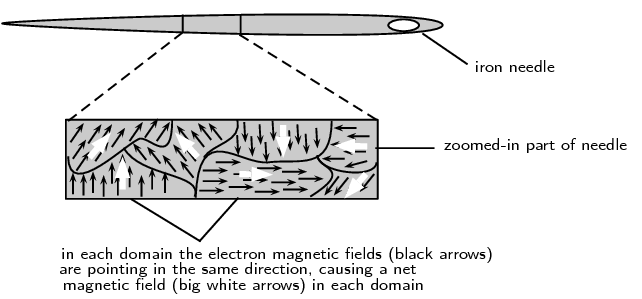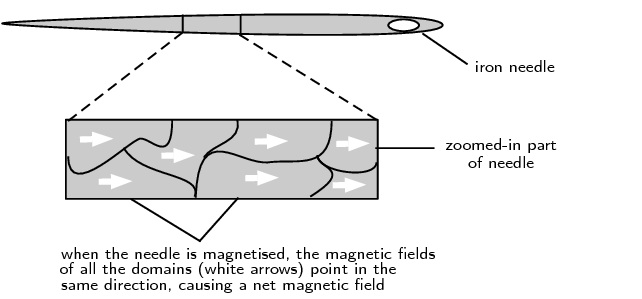15.2 Magnetic fields
|
Previous
15.1 Introduction
|
Next
15.3 Permanent magnets
|
15.2 Magnetic fields (ESAEG)
A magnetic field is a region in space where a magnet or object made of magnetic material will experience a non-contact, magnetic force.
A moving charged particle has a magnetic fields associated with it. One example of a charged particle that occurs in most matter is the electron. Electrons are in constant motion inside material, orbiting the nucleus in the atom which may also be moving, rotating or vibrating.
So electrons inside any object are moving and have magnetic fields associated with them. In most materials these fields point in various directions, so the net magnetic field is zero. For example, in the plastic ball below, the directions of the magnetic fields of the electrons (shown by the arrows) are pointing in different directions and cancel each other out. Therefore the plastic ball is not magnetic and has no magnetic field.

In some materials (e.g. iron), called ferromagnetic materials, there are regions called domains, where the electrons' magnetic fields line up with each other. All the atoms in each domain are grouped together so that the magnetic fields from their electrons point the same way. The picture shows a piece of an iron needle zoomed in to show the domains with the electric fields lined up inside them.

In permanent magnets, many domains are lined up, resulting in a net magnetic field. Objects made from ferromagnetic materials can be magnetised, for example by rubbing a magnet along the object in one direction. This causes the magnetic fields of most, or all, of the domains to line up in one direction. As a result the object as a whole will have a net magnetic field. It is magnetic. Once a ferromagnetic object has been magnetised, it can stay magnetic without another magnet being nearby (i.e. without being in another magnetic field). In the picture below, the needle has been magnetised because the magnetic fields in all the domains are pointing in the same direction.

Ferromagnetic materials and magnetisation
-
Find 2 paper clips. Put the paper clips close together and observe what happens.
-
What happens to the paper clips?
-
Are the paper clips magnetic?
-
-
Now take a permanent bar magnet and rub it once along 1 of the paper clips. Remove the magnet and put the paper clip which was touched by the magnet close to the other paper clip and observe what happens. Does the untouched paper clip experience a force on it? If so, is the force attractive or repulsive?
-
Rub the same paper clip a few more times with the bar magnet, in the same direction as before. Put the paper clip close to the other one and observe what happens.
-
Is there any difference to what happened in step \(\text{2}\)?
-
If there is a difference, what is the reason for it?
-
Is the paper clip which was rubbed repeatedly by the magnet now magnetised?
-
What is the difference between the two paper clips at the level of their atoms and electrons?
-
-
Now, find a metal knitting needle, or a metal ruler, or other metal object. Rub the bar magnet along the knitting needle a few times in the same direction. Now put the knitting needle close to the paper clips and observe what happens.
-
Does the knitting needle attract the paper clips?
-
What does this tell you about the material of the knitting needle? Is it ferromagnetic?
-
-
Repeat this experiment with objects made from other materials. Which materials appear to be ferromagnetic and which are not? Put your answers in a table.
A ferromagnetic material is a substance that shows spontaneous magnetisation. Spontaneous means self-generated or to happen without external cause. This means that a ferromagnetic material has a magnetic field without any external factors being required.
|
Previous
15.1 Introduction
|
Table of Contents |
Next
15.3 Permanent magnets
|
